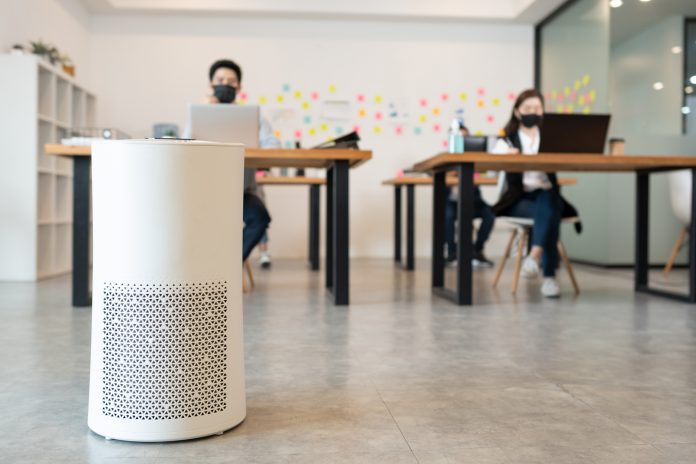Andrew Hobbs, CEO of Better Indoors, is currently engaging parliamentarians to discuss the need to utilise air purification technology to safely disinfect the air and surfaces in indoor spaces
When the COVID-19 virus first broke out in Europe in early 2020, UK Government were confident that the highly infectious respiratory disease could be easily maintained.
Fast forward 10 months and the situation is far from ‘controlled’ with recorded cases having exceeded 2 million, the number of recorded deaths in excess of 67,000 and the findings of a new COVID-19 variant plunging millions into last-minute lockdown restrictions, wreaking havoc countrywide.
Whether triumphant in keeping cases to a minimum or struggling to maintain growing numbers, countries across the globe have made it clear that they are taking zero chances with the new ‘highly transmissible’ variant, and, in an ironic move, have banned UK travel, completely isolating the country.
Likely to be recorded as one of the bleakest periods in UK history, Boris Johnson and his public sector peers have faced widespread scrutiny throughout the pandemic with missed deadlines, last-minute changes and the utter failure of a multi-billion-pound track and trace solution diminishing public trust and respect for our country’s leaders.
For those of us operating within the HVAC and air purification industry, this level of frustration is tenfold, as we sit watching the country falling to pieces, knowing there is one fundamental piece of the puzzle that has been missed by UK Government in its battle against COVID-19: Active Air Purification Technology.
What is active air purification technology?
In recent years, environmental air cleaning manufacturers have developed a host of solutions for both residential and commercial use, all of which claim to produce clean and healthy air for indoor environments. Before selecting one product over another It is important to understand what type of technology it contains, how that technology works, its safety and efficacy credentials and those of its manufacturer, especially now given the number of new firms that have arrived on the market since the pandemic hit.
Most air purification technologies are passive in that they can only have any effect when the air containing the pollutant comes into close proximity or passes through the unit. Examples of this are filtration, UV-C, and various PCO and ionisation technologies. In other words, certain operational conditions must be met in order for them to be effective.
Active technology is not limited in this way and is effective in every cubic cm of indoor air and surface space simultaneously and continuously. This means pollutants are instantly treated no matter where or when in the indoor space they are emitted or exposed which is significant in the context of COVID transmission. With active technology the virus is immediately subject to treatment whereas with passive technology the virus remains active until it passes by or through the unit. Importantly some technologies claim to be effective against SARS-CoV-2 but very few have been tested against the aerosolized form of the virus in real-world conditions and it is essential to understand this given how this virus transmits.
Whether required to mitigate microbials, allergens or dangerous gases and VOCs, active technology offers a unique solution to destroying microbials instantly, offering a safer, cleaner and more effective approach to air purification in domestic, commercial and industrial environments.
Why is active air purification technology ignored by UK Government?
Since its outbreak, a key focus for the Government in its fight against COVID-19 is ensuring the transmission or ‘R’ rate remains below 1, yet they fail to look at all measures available for control, particularly when it comes to air purification technology.
With extensive experience in the HVAC and air purification industries, I can state that current guidelines for helping to reduce the spread of COVID-19 are inadequate. For example, SAGE’s advice to leave windows open in environments such as homes and schools is particularly ineffective and unrealistic, as the virus remains alive and cold conditions are more helpful to the virus survival not to mention the comfort and cost issues this creates.
Therefore, as COVID-19 is an airborne and asymptomatic virus, SAGE should be in consultation with industry experts, the people behind the technology who have an unrivalled understanding of how airborne pollutants can be eliminated by purification technology.
Time and time again SAGE and UK Government have advised they won’t recommend individual products and will only consider technology that has been peer-reviewed as if that is a proxy for whether technology is effective or safe whilst at the same time ignoring the evidence of millions of users and significant independent safety and efficacy test evidence.
This subjective blinkered approach needs to be diminished in the interest of public health. Air cleaners with proven credentials for safety and efficacy including SARS-CoV-2 must be part of the discussion especially those with unique active attributes which can and do manage down the R rate. Had Government listened to the air purification industry some months ago, more lives would’ve been saved, economic disaster could have been evaded and now millions of people wouldn’t be facing the hardship of a challenging and restricted Christmas, isolated from their family and loved ones.
Now as we stand on our very last line of defence, it’s time for the Government to sit up and listen, to assess the true capabilities of proven active air purification technology in combatting COVID-19 and to make a strong U-turn on this virus once and for all.











